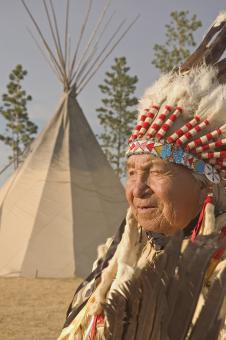American Indians
Locations
The Plains Indians - the proud first residents of the Rocky Mountain West - still make the region their home. In recent years, a new sense of vision and cultural awareness has grown between whites and Native Americans. The region is home to sixteen Indian nations.
To find more information on the American Indians in our region, please visit the official websites of Idaho, Montana, South Dakota and Wyoming. You can also view our American Indian sample itinerary or review annual festivals and events here.
South Dakota
As the ancestral home of the Lakota, Nakota and Dakota tribes - known collectively as the Great Sioux Nation - South Dakota offers visitors an opportunity to experience authentic Native American culture. Travel the Native American Scenic Byway through the heart of the Great Sioux Nation. Visit the tribal lands of the state's nine Indian tribes. View and purchase native arts and crafts. Or witness the pageantry of a Native American powwow: Rapid City's annual Black Hills Powwow attracts native singers, dancers and drummers from across the American West.
Wyoming
Once home to more than a dozen Indian tribes, Wyoming today counts among its residents more than 11,000 Shoshone and Arapaho Indians who live on the Wind River Reservation. Located southeast of Jackson, the 2.2 million-acre reservation is the site of festive Indian powwows each summer. The Plains Indian Museum also holds an annual powwow in the Robbie Powwow Garden at the Buffalo Bill Historical Center in Cody. Wyoming is home to numerous sites held sacred by Native Americans, including Devils Tower (also known as Bears Lodge) and the intriguing Medicine Wheel National Historic Site. Located in Bighorn National Forest near Lovell, the ancient stone circle with interior "spokes" has been likened to Stonehenge, and is believed to have been constructed by Indian tribes for religious or astrological purposes between 1200 and 1700 AD. Today, the site is used by Native Americans for religious ceremonies, and is open to the public from June to September.
Montana
Montana makes it easy for history buffs to experience a taste of what life in the untamed West was like hundreds and even thousands of years ago. In particular, the state's Native American heritage is well preserved. The ancestral lands of the Blackfeet Indians, Montana is home to seven Indian reservations and 11 tribes whose powwows and other tribal events are not to be missed. Visit the Museum of the Plains Indian in Browning - site of the annual North American Indian Days summer festival - or immerse yourself in the traditions of the Salish and Kootenai tribes on the nearby Flathead Indian Reservation. Witness what's believed to be the largest modern-day encampment in the world. at the annual week-long Crow Fair and Rodeo, a celebration of the Apsáalooke Nation held each August in Crow Agency.
Idaho
In Idaho, the Nez Perce National Historic Trail includes 38 sites across four states, including Spalding's Nez Perce National Historical Park Visitor Center. The Nez Perce National Historic Park bring alive the ten thousand-year-history of the Nez Perce people. The visitor's center contains a museum and an auditorium with interpretive talks and films. Visit the Sacajawea Center in Salmon to learn more about the Shoshone Indian woman who guided the Lewis and Clark expedition. The Cataldo Mission, near Coeur d'Alene, was built between 1848 and 1853 by the Coeur d'Alene Indians under the direction of the Italian Jesuit missionary, Father Ravalli. It is the oldest standing building in Idaho and is constructed of carefully woven straw, river mud and wooden pegs. Fort Hall is the home of both the Shoshone and Bannock Native Americans who have peacefully inhabited the same land in southern Idaho for thousands of years. The tribes host the Sho-Ban Indian Festival each year during the second weekend in August. The tribal museum and trading post are open to the public year round.
Native American Etiquette
In the Real America, our focus on the great states of Montana, Wyoming, South Dakota and Idaho has always been centered on their natural beauty, their thriving tourism industries and the part each played in shaping American’s west into the diverse and vibrant enclave it is today. One central aspect of each state’s history and modern culture is the fascinating role Native Americans played – and continue to play – in America’s West. As a visitor to the Real America Region, you have the opportunity to learn and experience firsthand how Native American tribes continue to provide valuable economic and cultural contributions to the American Rockies region. As you begin to explore, however, it is very important to keep in mind that customs and Native American laws should at all times be heeded in order to make this experience as productive and meaningful as possible for all parties. Below are several points that should be considered as you venture into Native American territory:
- If you are witnessing a tribal ceremony, discretion is always the best route – at least initially. Always assume the role of “fly on the wall” spectator during a ritual, making certain to never get in the way of those conducting or participating in the ceremony. There are instances, or course, when outside participation is welcomed by the emcee, at which point you should feel free to volunteer and join in!
- Please refrain from touching or handling any of the feather or buckskin outfits of dancers or those in regalia, unless expressly invited to. These items often have ceremonial and personal meaning to the owner, and many of these outfits may be identified as family heirlooms.
- While photographs and video recording is a great way to capture the authentic beauty of Native American customs and regalia, it is never a good idea to do so without first having express permission. Furthermore, certain rituals that require intense concentration from the participants (such as dance and drum ceremonies) can be disrupted by flash photography. Always use your best judgment and be certain to have permission before shooting or filming.
- Respect and obey all tribal laws. Tribes are sovereign nations on American soil and have jurisdictional rights.
- It is unlawful to harvest, gather or remove plants, medicines or trees from tribal grounds without express permission from a tribal representative.
- It is highly illegal to pick up or loot artifacts from sacred sites, burial, traditional and cultural properties. It is equally forbidden to trespass on any of these sites without proper escort.
- It can be construed as a sign of disrespect to openly discuss burials, burial sites, and those who have passed on.
- As a sign of deference (and a sign of common sense!) do not ever bring drugs or alcohol on any reservation or tribal territory. Alcohol and drugs are forbidden at all ceremonies, powwows and tribal events.
- Remember: When in doubt, ask first!
Part of the exceptional culture and history in the featured states of Montana, Wyoming, South Dakota and Idaho are firmly rooted in Native American tradition. As you explore everything these states have to offer, simply keep in mind these few guidelines. As you immerse yourself in the region's Native American history, please keep in mind the few guidelines above and respectfully enjoy all they have to offer!
Featured Photos
- 1 of 5
- next ›

Quality content
- Casino Online Senza Autoesclusione
- Non Gamstop Casinos
- Non Gamstop Casino
- Gambling Sites Not On Gamstop
- Casino Sites Not On Gamstop
- Gambling Sites Not On Gamstop
- Casino Sites Not On Gamstop
- Online Betting UK
- Non Gamstop Casinos
- Online Casinos Canada
- Casinos UK Not On Gamstop
- オンラインカジノ
- UK Casino Not On Gamstop
- Casino Not On Gamstop
- Sites Not On Gamstop
- Non Gamstop Casino Sites UK
- Sites Not On Gamstop
- UK Slot Sites
Open Standard Media Player version 1.3











